Disclosure: Please note that some links are affiliate links, and at no additional cost to you, we earn a commission if you make a purchase.
If you would like to support this website in some way, using these links will help do exactly that.
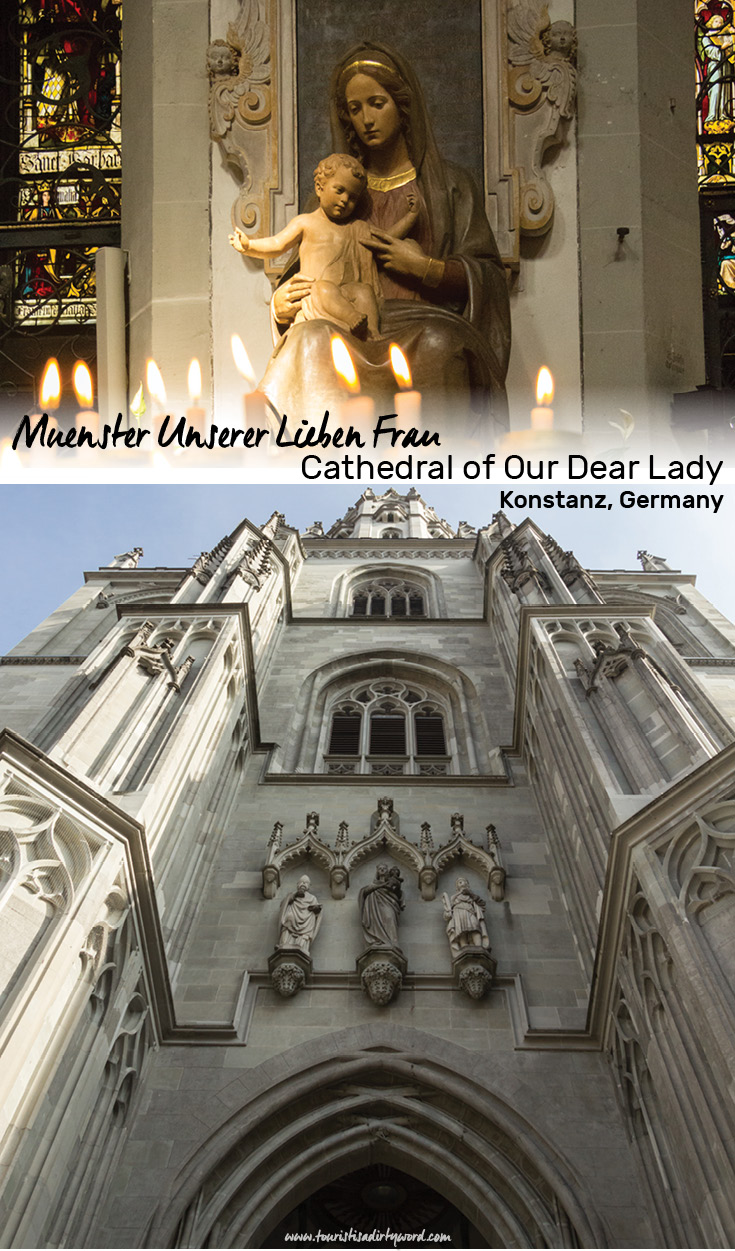
We wandered only a short distance through the old part of town before spotting the highest tower of the Cathedral, then used it as our compass. In Konstanz, Germany, we sought out the Muenster Unserer Lieben Frau, Cathedral of Our Dear Lady. We opened one of the side nave doors, and found ourselves surrounded by tracery windows, and stained glass windows with the afternoon sun shining through them. 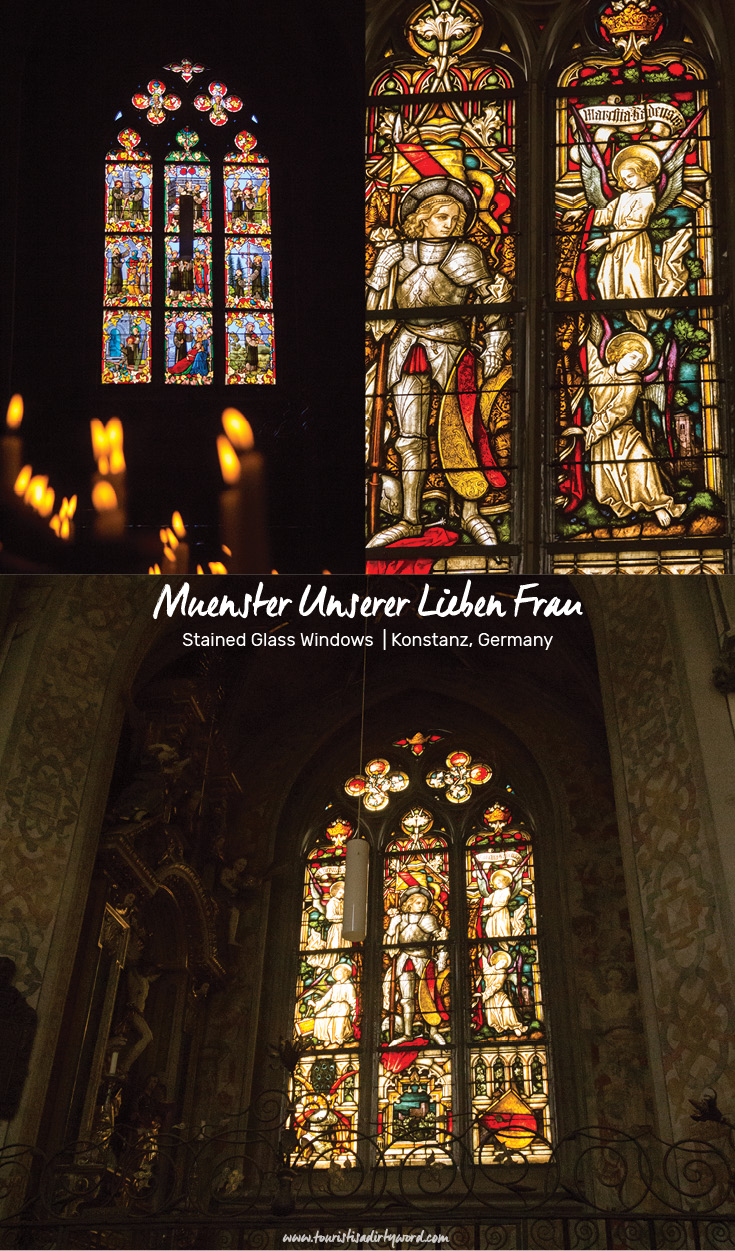
It took a moment for my eyes to adjust, and I took a deep breath. The interior of the cathedral is brighter than I expected, and with almost all church/castle/cathedral/palace.. your eyes tend to wander up. The original Romanesque painted wood ceilings are long gone, but the whitewashed, plastered ribbed vault ceiling is pretty, and does make the Cathedral bright and spacious.
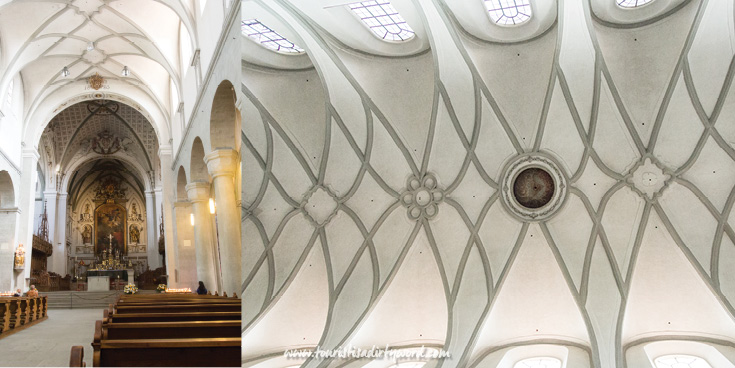
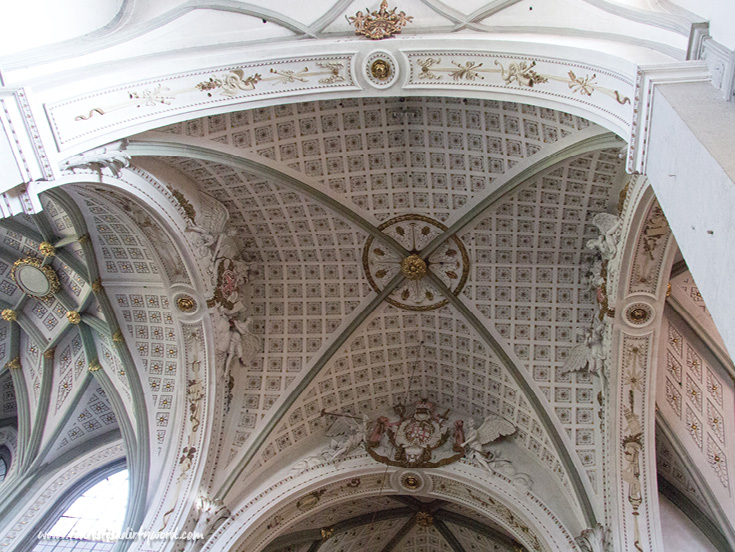
Don't Miss This-
Allow a healthy hour to explore the whole cathedral. There are truly details everywhere, even the crypt. Don't let the word 'crypt' scare you. It felt more like a basement or a cellar, and while it did have low-sloped ceilings, its not cramped. If you venture down, you'll discover three copperplates, one large plate depicting Christ which dates back to the 10th century, and two smaller copper plates from the 13th century. The faceless figure in one of the smaller copper plates depicts the patron saint of Konstanz, Saint Pelagius, whose relics were held for a time in the tomb that is opposite the copperplates.
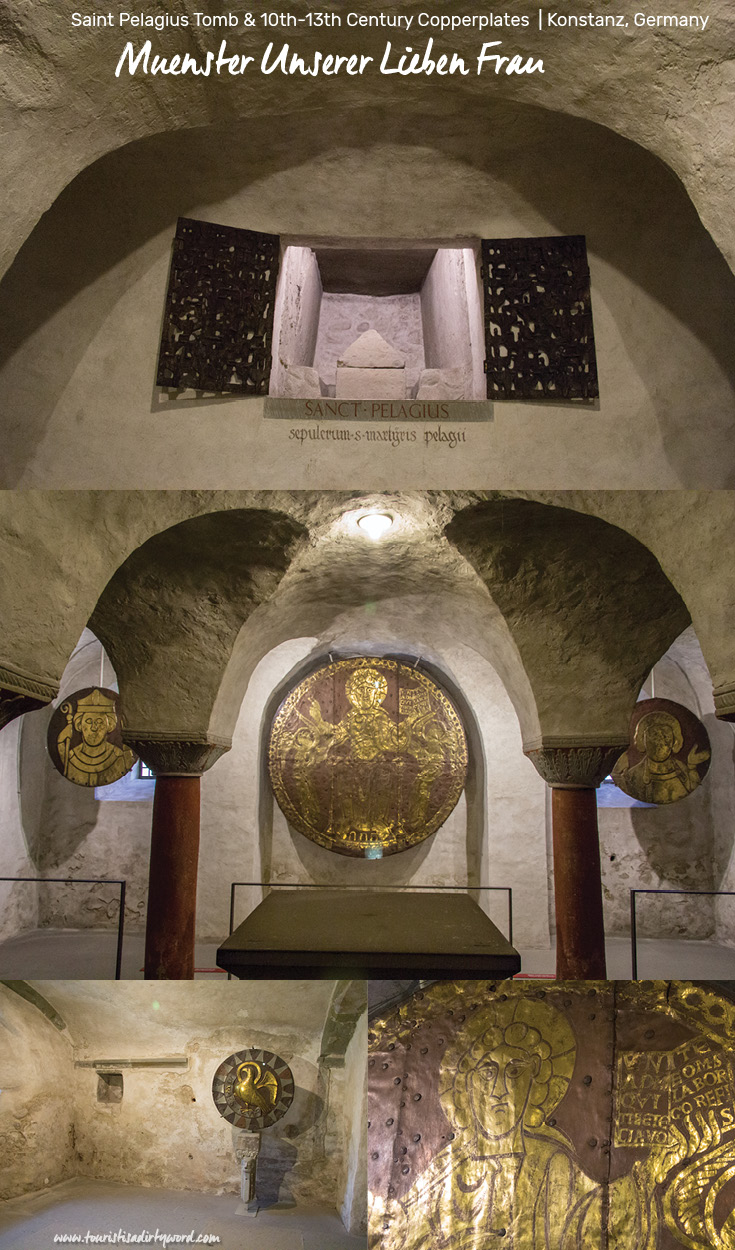
Its hard to beat stained glass windows in wow-factor, but look for the wooden spiral staircase that leads to the pulpit. If you have time, try and plan for hearing the Cathedral bells ring, which are fondly considered by some as one of the most harmonious in Germany.
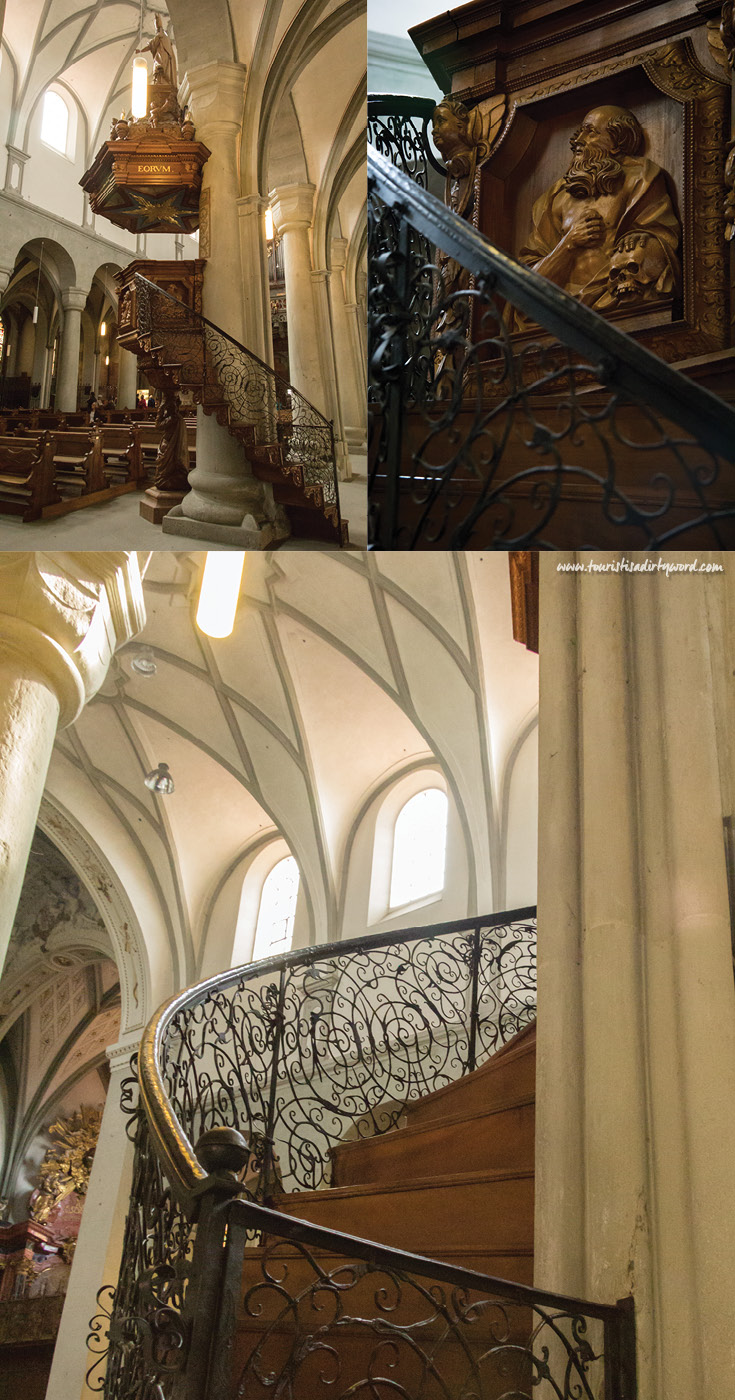
BONUS Konstanz Cathedral Architectural History, in English
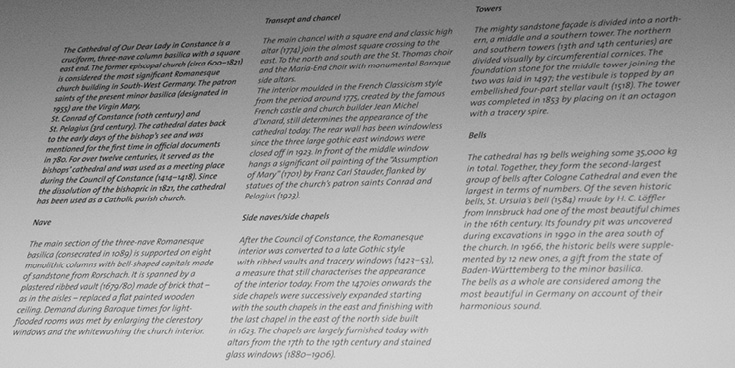
It would be a disservice to try and summarize the English synopsis of the cathedral's history that was on display in the entryway. I've looked online and I can't see it posted anywhere, so I've retyped it from a photo I took. The Wikipedia page for Muenster Unserer Lieben Frau in English is an 1/8th of the size of the page in German, so here's to bridging the language barrier in regards to this stunning building.The official website for the cathedral is completely in German as well.
"Cathedral of Our Dear Lady in Constance is a cruciform, three-nave column basilica with a square east end. The former episcopal church (circa 600-1821) is considered the most significant Romanesque church building in South-West Germany. The patron saints of the present minor basilica (designated in 1955) are the Virgin Mary, St. Conrad of Constance (10th century) and St. Pelagius (3rd century). The cathedral dates back to the early days of the bishop's see and was mentioned for the first time in official documents in 780. For over twelve centuries, it served as the bishops' cathedral and was used as a meeting place during the Council of Constance (1414-1418). Since the dissolution of the bishopric in 1821, the cathedral has been used as a Catholic parish church.
Nave
The main section of the three-nave Romanesque basilica (consecrated in 1089) is supported on eight monolithic columns with bell-shaped capitals made of sandstone from Rorschach. It is spanned by a plastered ribbed vault (1679/80) made of brick that- as in the aisles- replaced a flat painted wooden ceiling. Demand during Baroque times for light-flooded rooms was met by enlarging the clerestory windows and the whitewashing the church interior.
Transept and chancel
The main chancel with a square end and classic high altar (1774) join the almost square crossing to the east. To the north and south are the St. Thomas choir and Maria-End choir with monumental Baroque side altars. The interiors moulded in the French Classicism style from the period around 1775, created by the famous French castle and church builder Jean Michel d'Ixnard, still determines the appearance of the cathedral today. The rear wall has been windowless since the three large gothic east windows were closed off in 1923. In front of the middle window hangs a significant oil painting of the "Assumption of Mary" (1701) by Franz Carl Stauder, flanked by the statues of the church's patron saints Conrad and Pelagius (1923).
Side naves/Side chapels
After the Council of Constance, the Romanesque interior was converted to a late Gothic style with ribbed vaults and tracery windows (1423-53), a measure that still characterizes the appearance of the interior today. From the 1470s onwards the side chapels were successively expanded starting with the south chapels in the east and finishing with the last chapel in the east of the north side built in 1623. The chapels are largely furnished today with the altars from the 17th and 19th century and stained glass windows (1880-1906).
Towers
The mighty sandstone facade is divided into a northern, a middle, and a southern tower. The northern and southern towers (13th and 14th centuries) are divided visually by circumferential cornices. The foundation stone for the middle tower joining the two was laid in 1497; the vestibule is topped by an embellished four-part stellar vault (1518). The tower was completed in 1853 by placing on it an octagon with a tracery spire.
Bells
The cathedral has 19 bells weighing some 35,000 kg in total. Together, they form the second-largest group of bells after Cologne Cathedral and even the largest in terms of numbers. Of the seen historic bells, St. Ursula's bell (1584) made by the H.C. Löffler from Innsbruck had one of the most beautiful chimes in the 16th century. Its foundry pit was uncovered during excavations in 1990 in the area south of the church. In 1966, the historic bells were supplemented by 12 new ones, a gift from the state of Baden-Württenberg to the minor basilica. The bells as a whole are considered among the most beautiful in Germany on account of their harmonious sound."
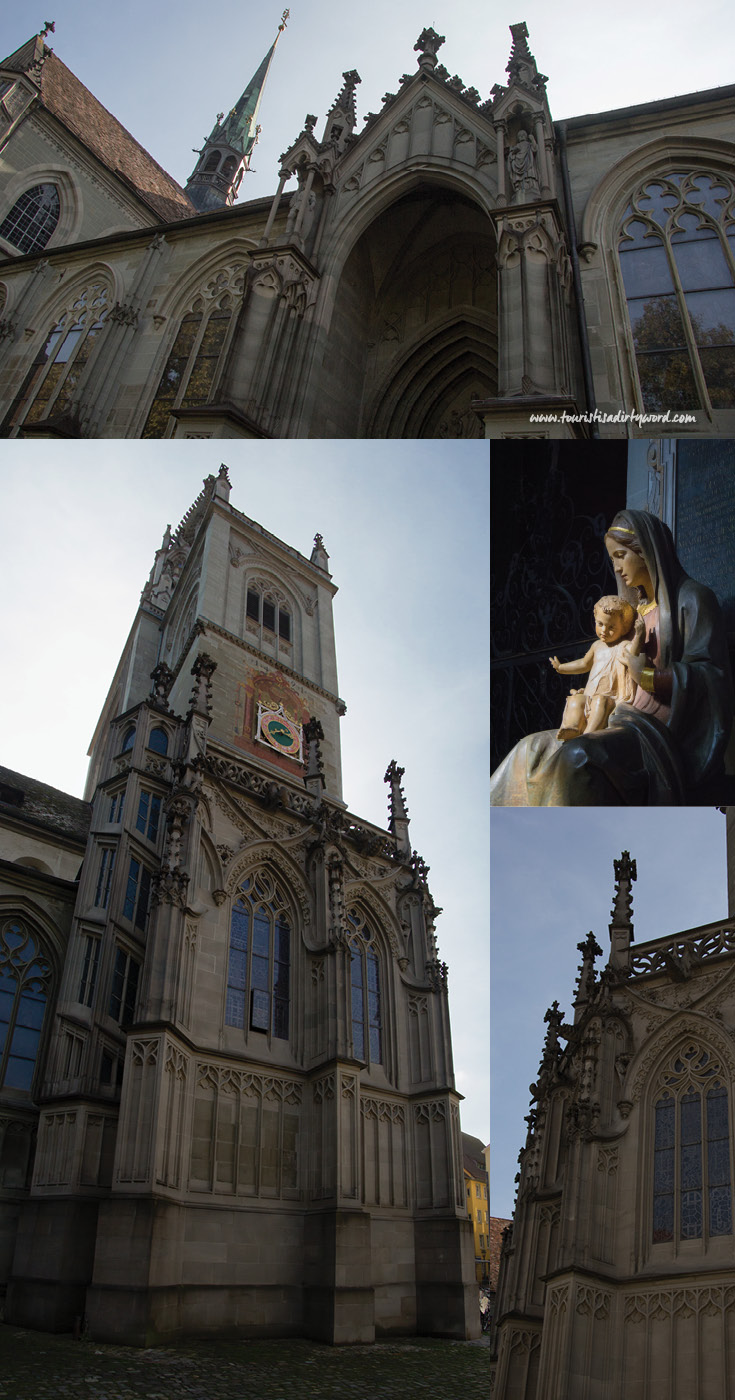
Follow Along
If you enjoyed this article, or these topics sound interesting to you, you'll love our weekly newsletter. You'll receive a free Germany Packing list for signing up, and you'll receive each week's newest posts every Friday. Thank you for reading!

An island of flowers? It's not the first image that pops into my mind when I think of Germany. As we were planning our family trip to Lake Constance and it's towns, the flower-filled island of Mainau popped up. I’m passionate about flowers, and deeply appreciate the labor that goes into making beautiful gardens. Seeing the recommendations that you can easily spend a half day, or full day there, I was really looking forward to exploring Mainau.
To kick off our flower adventure, we needed to cross Lake Constance. We rented a house for the week in Meersburg, and the fastest, cheapest way to get there was by ferry boat. And not just any ferry boat, a ferry boat that carries cars! It would be my first time on a car ferry. We were so lucky, as we pulled up to the ferry boat, we realized we would be the first in the line of cars. Our view from our car would be perfect! While we were waiting, a man walked up and down the cars selling newspapers. It boggled my mind that this was for many an every day commute! Lake Constance was foggy this early in the morning, and there was a nip of chill in the air. Torn between wanting to hear the water and the birds or staying warm inside the car, we compromised and rolled one window down. It made for better photos that way too.
After the ferry ride, it was just a short drive to the parking lot where we left all wheels behind. We paid our admission, and walked along a short path by the lake and spied the feathered residents enjoying breakfast. We saw several ducks and swans diving down and up again.
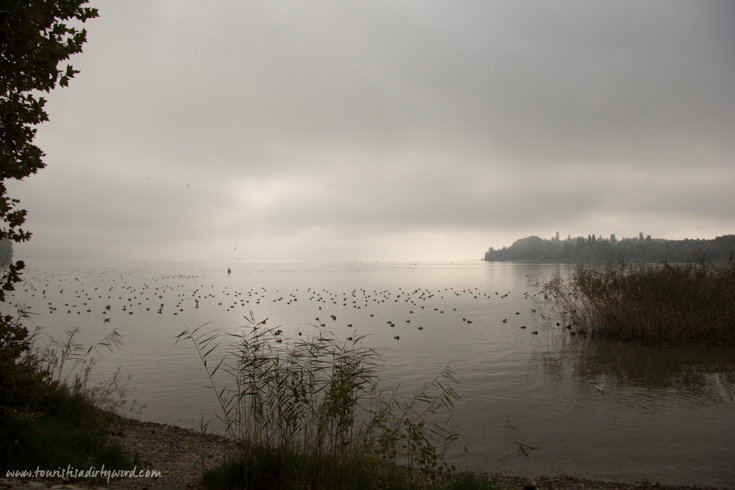
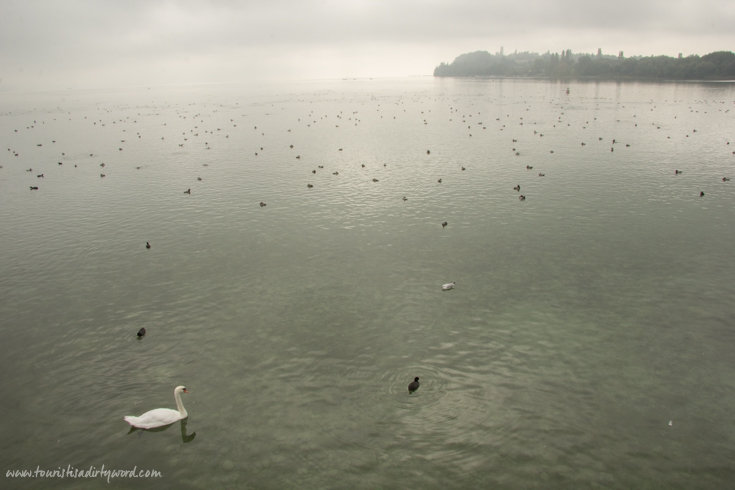
There are several circuits that you can take around the island and we chose to walk counterclockwise. Right away, we saw a group of duck sculptures built out of flowers, then an extravagant peacock built out of flowers! It was like being in Cypress Gardens again. There was once a fantastic botanical park in Winter Haven, Florida called Cypress Gardens, and they had numerous animal sculptures built entirely of flowers. My grandparents used to take my brother and I every time we came to visit. It's no longer open, and has been transformed into a Legoland Theme Park. It made my heart smile to know in Germany flower animal sculptures still exist.
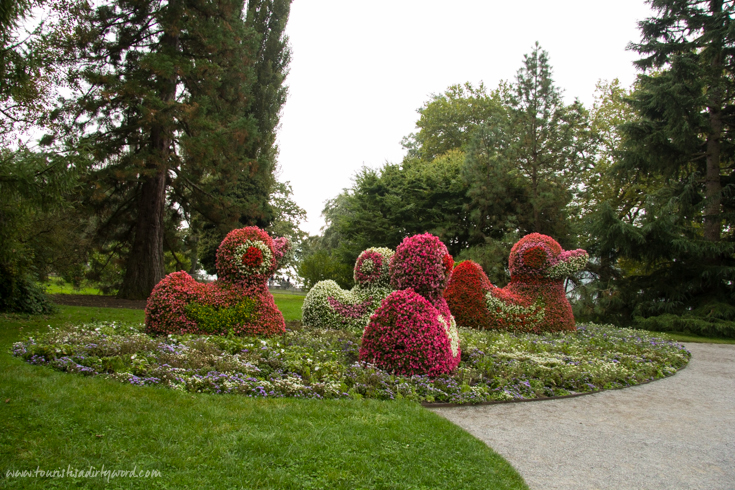
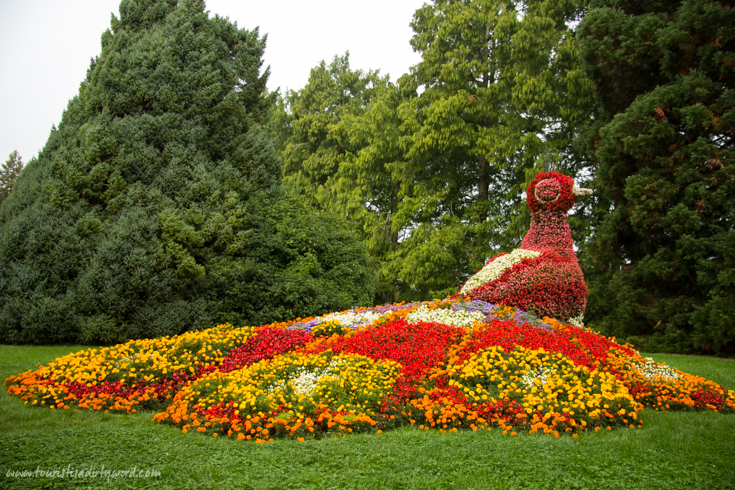
Then we discovered a miniature farm where a rabbit had chickens and roosters for roommates. The rabbit had an extra espresso carrot that morning and sprinted in between the roosters, startling them. It was comical to watch. There was a goat who said good morning, and we visited with a calm, orange tabby cat that was not phased by anything. With the morning sunshine starting to bust up the fog clouds, his orange fur was angelically lit.
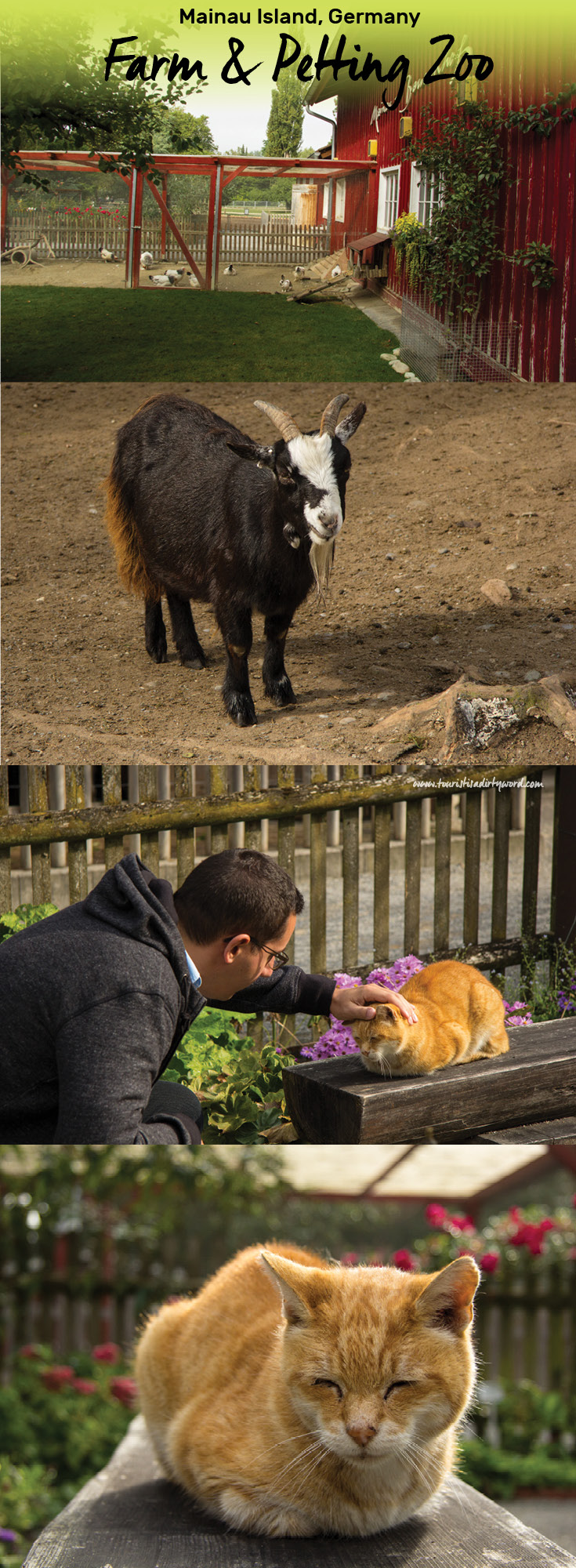
The farm was beside an area with a charming wooden bear stuck in a tree log, and a moss-covered troll couple.
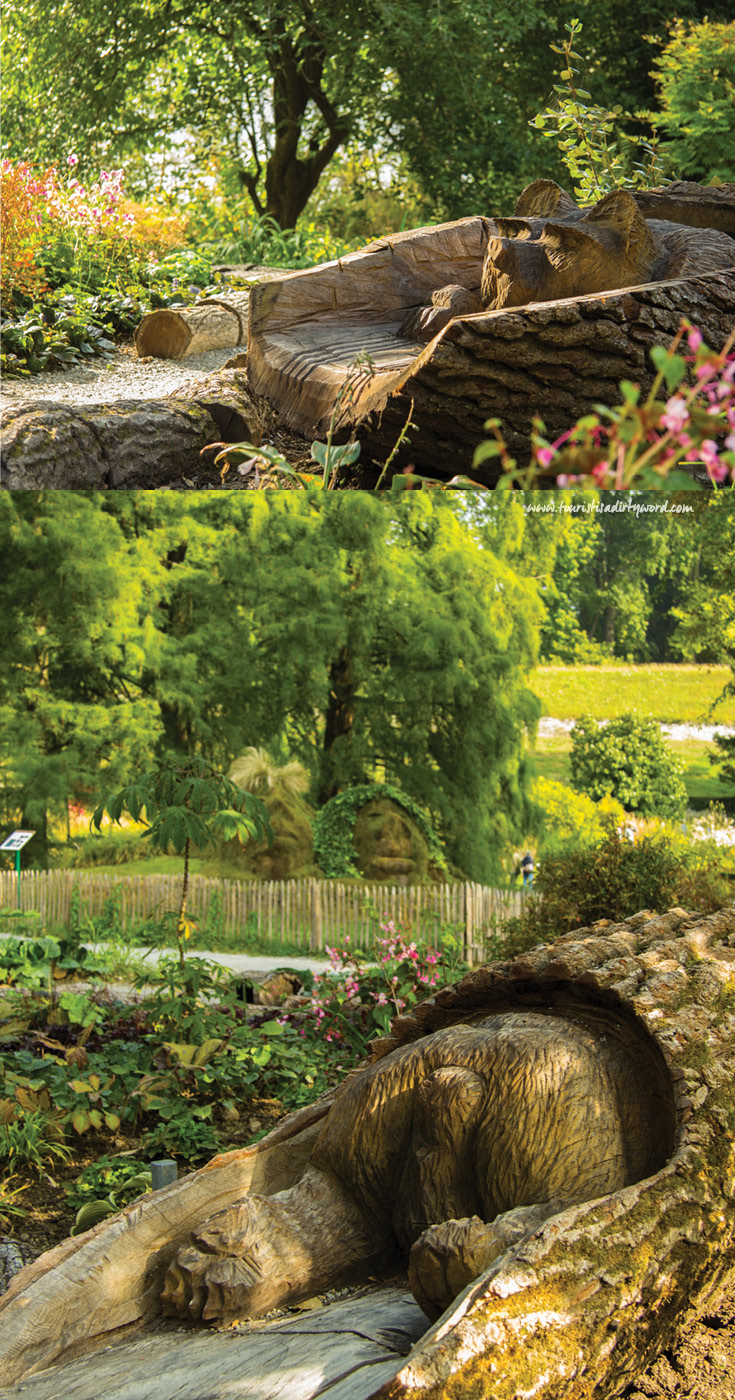
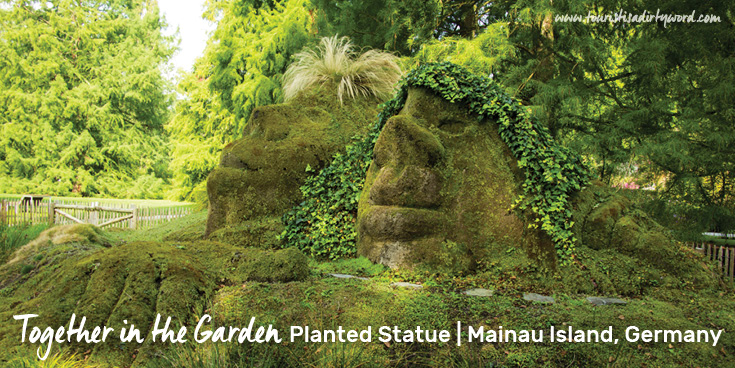
The path we were on wound up and down the shore of Lake Constance. I loved the Dahlia garden which were in season, and they had about 75 to 80 different varieties on display.
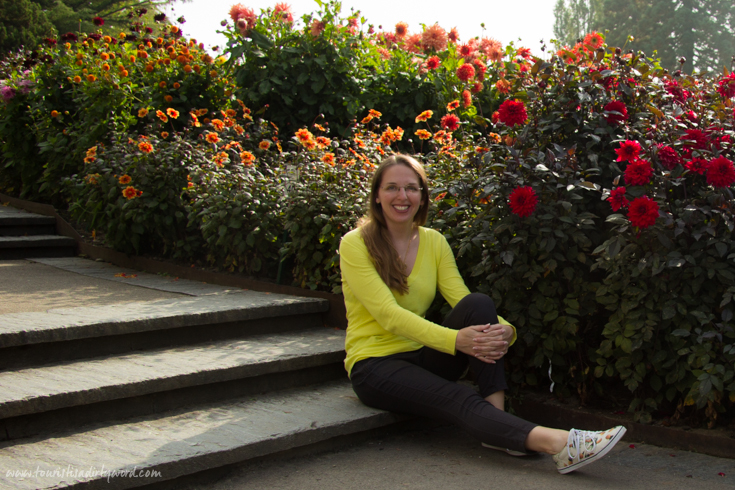
Further along, we saw the Italian cascading fountain, and the map of Lake Constance illustrated through flowers.
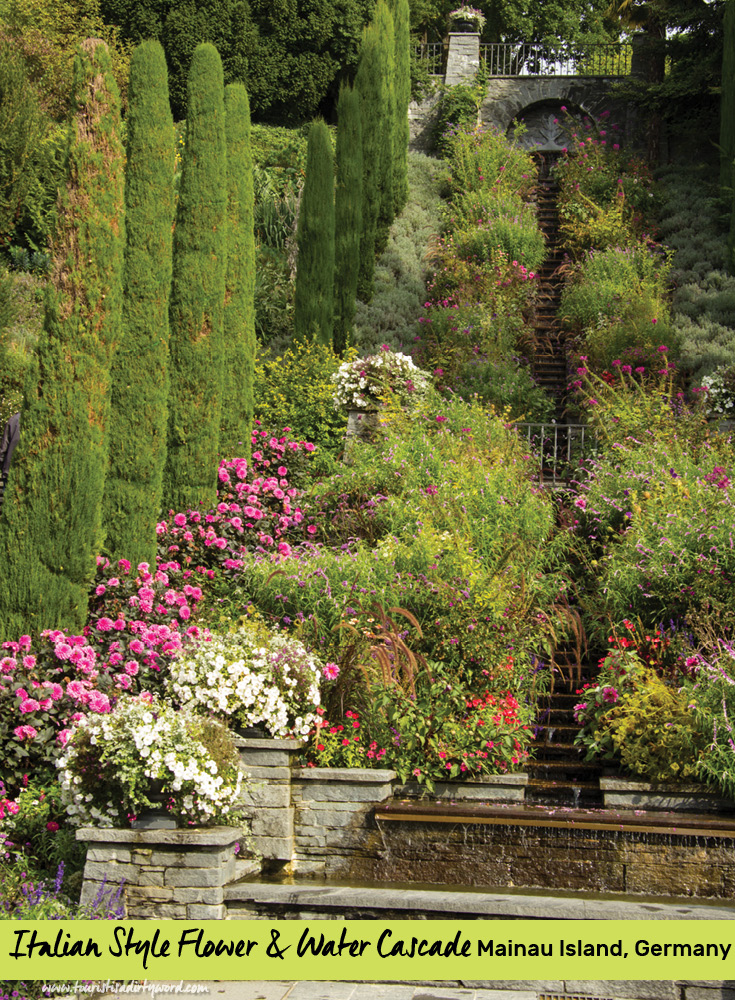
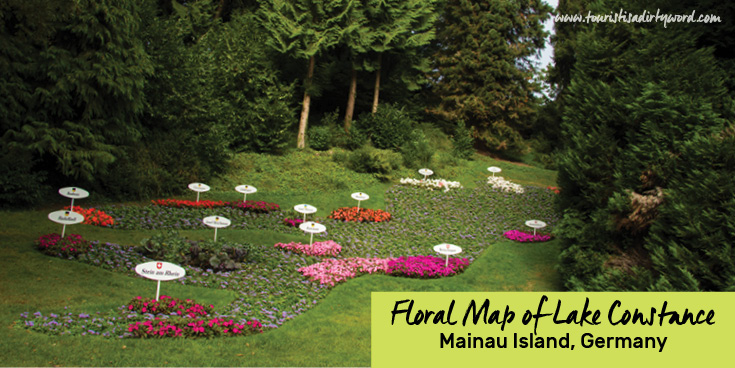
We took a break at a garden cafe where the tables had built-in flower planters. It was just what we needed, walking halfway around Mainau Island already.
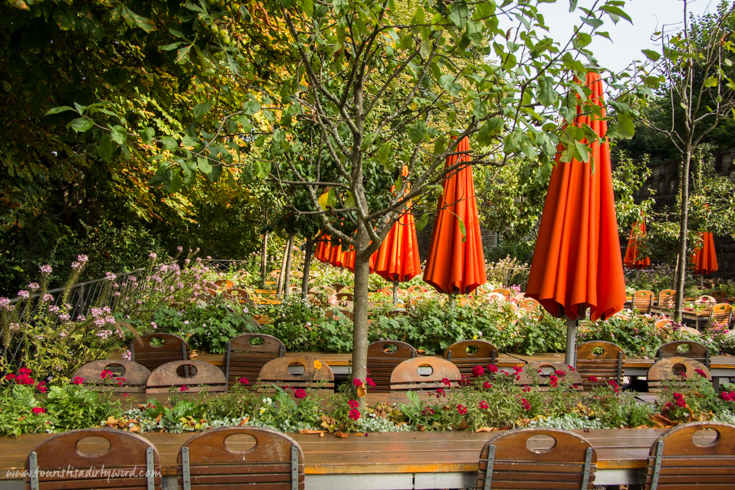
On top of the hill, the 13th-century Baroque palace and church stands from the time the Teutonic Knights owned the island. Alongside the church is an Italian rose garden complete with statuary and fountains. Wherever we looked there were colorful blooms surrounded by lots of greenery.
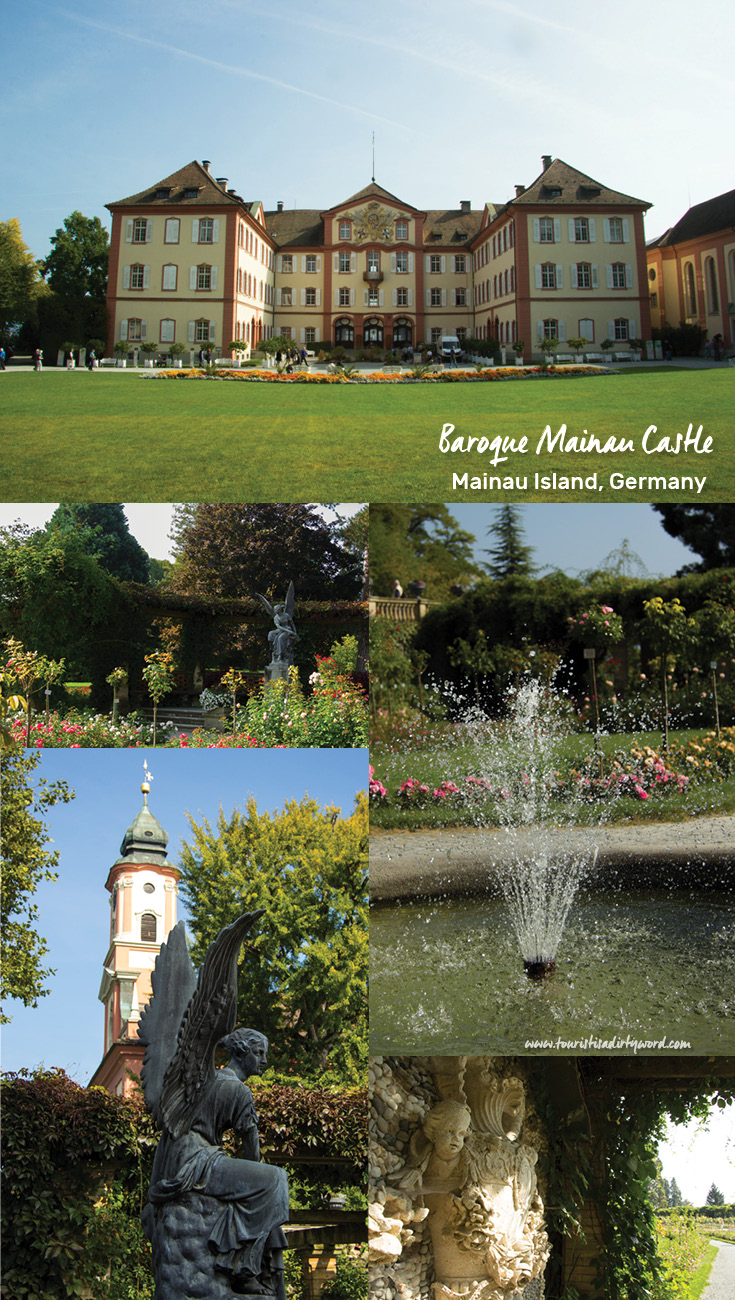
We passed giant redwood trees on our way to the butterfly house. The butterfly house was overwhelmingly crowded, both with people and butterflies. A pond with a waterfall entertained a gang of turtles, gorgeous orchids hung from the ceiling, and butterflies were everywhere. Specific feeding trays put out for the butterflies was a sure-fire way to get a good photo. I made myself dizzying trying to photograph a few of them! There was always a fluttering of wings passing overhead.

By the end of the day it felt like we had seen the entire Nature Encyclopedia. It was refreshing, and a wonderful experience not to be missed, if your ventures take you to Lake Constance.

Follow Along
If you enjoyed this article, or these topics sound interesting to you, you'll love our weekly newsletter. You'll receive a free Germany Packing list for signing up, and you'll receive each week's newest posts every Friday. Thank you for reading!

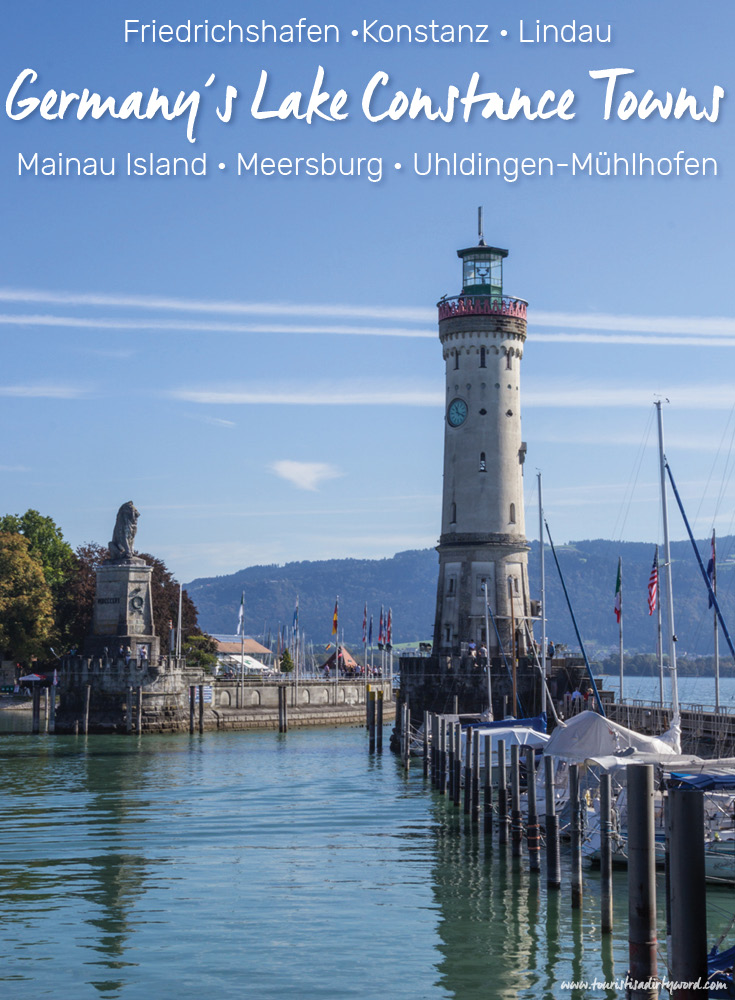
On the southern border of Germany you will find Lake Constance, also called Bodensee. It borders Germany, Switzerland and Austria and is the largest drinking water storage in Europe. More than 20 different municipalities extract the water of Lake Constance, which supplies about four million people with drinking water.
It has been on our must-see list for quite a while and even after spending 4 days there, we still feel that there is much more to see and explore. This month we will show you our highlights from our recent trip.
Upcoming Posts Featuring Lake Constance:
• History • Meersburg Castle is one of Germany’s oldest castles with more than 30 rooms to explore. Right next to it is the summer residence Neues Schloss with perfect views of shimmering Lake Constance
• Landmark • The seaside resort town of Lindau is so charming we spent all day there.
• Architecture • The architecture in the stunning cathedral of Konstanz, Muenster Unserer Lieben Frau.
• Museum • We go up in the air at the Zeppelin Museum in Friedrichshafen, and later explore early settlements at the Pile Dwelling Museum in Uhldingen-Mühlhofen.
• Nature • We take the ferry over to Mainau Island, also called the island of flowers. A must-see if you are going to Lake Constance.
Follow Along
If you enjoyed this article, or these topics sound interesting to you, you'll love our weekly newsletter. You'll receive a free Germany Packing list for signing up, and you'll receive each week's newest posts every Friday. Thank you for reading!

